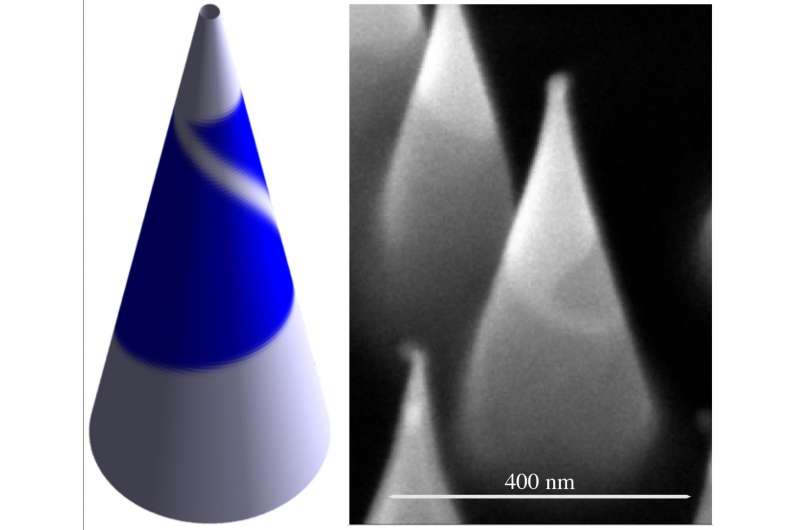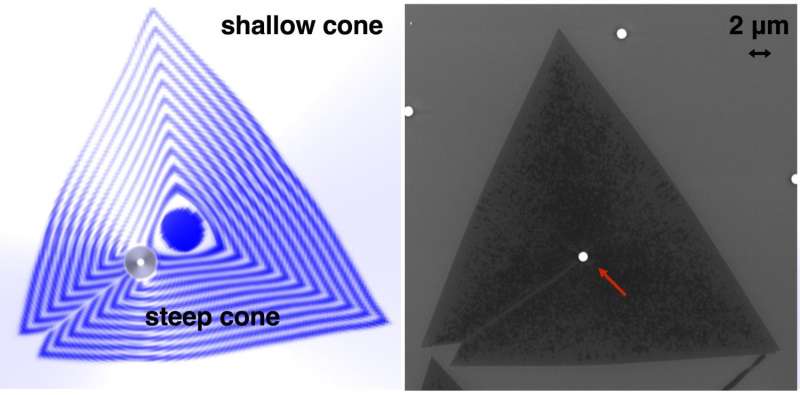Scientists show growing atom-thin sheets on cones allows control of defects

Rice University researchers have learned to manipulate two-dimensional materials to design in defects that enhance the materials' properties.
The Rice lab of theoretical physicist Boris Yakobson and colleagues at Oak Ridge National Laboratory are combining theory and experimentation to prove it's possible to give 2-D materials specific defects, especially atomic-scale seams called grain boundaries. These boundaries may be used to enhance the materials' electronic, magnetic, mechanical, catalytic and optical properties.
The key is introducing curvature to the landscape that constrains the way defects propagate. The researchers call this "tilt grain boundary topology," and they achieve it by growing their materials onto a topographically curved substrate—in this case, a cone. The angle of the cone dictates if, what kind and where the boundaries appear.
The research is the subject of a paper in the American Chemical Society journal ACS Nano.
Grain boundaries are the borders that appear in a material where edges meet in a mismatch. These boundaries are a series of defects; for example, when two sheets of hexagonal graphene meet at an angle, the carbon atoms compensate for it by forming nonhexagonal (five- or seven-member) rings.

Yakobson and his team have already demonstrated that these boundaries can be electronically significant. They can, for instance, turn perfectly conducting graphene into a semiconductor. In some cases, the boundary itself may be a conductive subnanoscale wire or take on magnetic properties.
But until now researchers had little control over where those boundaries would appear when growing graphene, molybdenum disulfide or other 2-D materials by chemical vapor deposition.
The theory developed at Rice showed growing 2-D material on a cone would force the boundaries to appear in certain places. The width of the cone controlled the placement and, more importantly, the tilt angle, a crucial parameter in tuning the materials' electronic and magnetic properties, Yakobson said.
Experimental collaborators from Oak Ridge led by co-author David Geohegan provided evidence backing key aspects of the theory. They achieved this by growing tungsten disulfide onto small cones similar to those in Rice's computer models. The boundaries that appeared in the real materials matched those predicted by theory.

"The nonplanar shape of the substrate forces the 2-D crystal to grow in a curved 'non-Euclidian' space," Yakobson said. "This strains the crystal, which occasionally yields by giving a way to the seams, or grain boundaries. It's no different from the way a tailor would add a seam to a suit or a dress to fit a curvy customer."
Modeling cones of different widths also revealed a "magic cone" of 38.9 degrees upon which growing a 2-D material would leave no grain boundary at all.
The Rice team extended its theory to see what would happen if the cones sat on a plane. They predicted how grain boundaries would form over the entire surface, and again, Oak Ridge experiments confirmed their results.
Yakobson said both the Rice and Oak Ridge teams were working on aspects of the research independently. "It was slow going until we met at a conference in Florida a couple of years back and realized that we should continue together," he said. "It was certainly gratifying to see how experiments confirmed the models, while sometimes offering important surprises. Now we need to do the additional work to comprehend them as well."
More information: Henry Yu et al, Tilt Grain Boundary Topology Induced by Substrate Topography, ACS Nano (2017). DOI: 10.1021/acsnano.7b03681
Journal information: ACS Nano
Provided by Rice University





















